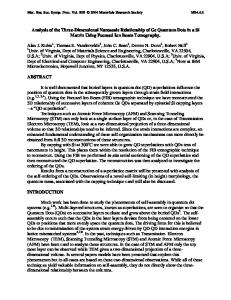Mechanism of the Preferential Edge-Positioning of Self-Organized Ge Quantum Dots on Si Mesas
- PDF / 1,894,781 Bytes
- 6 Pages / 417.6 x 639 pts Page_size
- 89 Downloads / 268 Views
In this work, we investigate the formation of self-organized Ge quantum dots on patterned Si (001) substrates, which were fabricated by conventional photo-lithography on thermally pre-grown silicon dioxide. After selectively growing Si mesas on the patterned substrates, we study the morphology and the strain field distribution on the mesas and find that tensile strain exists at the edges and compressive strain at the central region due to the mass transfer effect in the SEG process. Combining with AFM results, we suggest that the strain field distribution on the Si mesas influence the location of Ge dots, leading to the preference of edge positioning. EXPERIMENT The substrates in this study were patterned Si (001) substrates, which were fabricated by conventional photo-lithography on thermally pre-grown silicon dioxide with a thickness of about 400 nm.
After the process the Si surface was partially covered with silicon
dioxide. The Si window patterns in this study were along the orientation. The patterned Si (001) substrates were cleaned by degreasing in organic solutions, then cleaned by boiling in a mixture of NH 4OH : H 20 2 : H 20 (1:2:6 in volume), and finally transferred into the N2 gas box and dipped in a diluted HF solution to form a hydrogenterminated surface. The growth was carried out in a gas source MBE system with a gas source of Si2H6 and a Ge Knudsen source. After thermal cleaning at 890'C, about 60 nm Si was selectively grown in exposed Si windows at 6600 C with a growth rate of about 0.1 nm/s. Si mesas with facets were thus formed. Details on facet formation using SEG process may be found in previous publication [14]. After Si growth, Ge was deposited at a growth temperature within 600 and 7000 C and a growth rate of about 0.01 nm/s. The Ge growth rate was stabilized by controlling the cell temperature within an error of +±1C,and the rate was calibrated with Auger electron spectroscopy (AES) and atomic force microscopy (AFM) measurements. After the growth, the samples were removed from the vacuum and inserted into a diluted HF solution to etch the silicon oxide on the surface for AFM study. The sample morphology and Ge dots were then ex-situ examined by AFM with a contact mode. The Raman measurements were performed in backscattering configuration at room temperature on a micro-Raman system using the 514.5 nm line of an Ar+ laser as the excitation source. The laser spot size was 7 ltrm for the imaging measurements and the imaging spatial resolution (a pixel dimension) was 0.1 gtm. RESULTS AND DISCUSSIONS Due to the anisotropy of growth rate on different surfaces in the SEG process, sidewall facets were frequently formed on patterned Si (001) and evolved from the {113}dominated at the initial stage of the Si selective growth to the I111 }-dominated at larger Si thickness. In this study, the {1131 sidewall facets dominate the mesa sides at Si coverage of about 60 nm. Fig. 1(a) shows a two-dimensional AFM image of a typical Si mesa selectively grown on patterned substrates. The cross section of the m
Data Loading...










